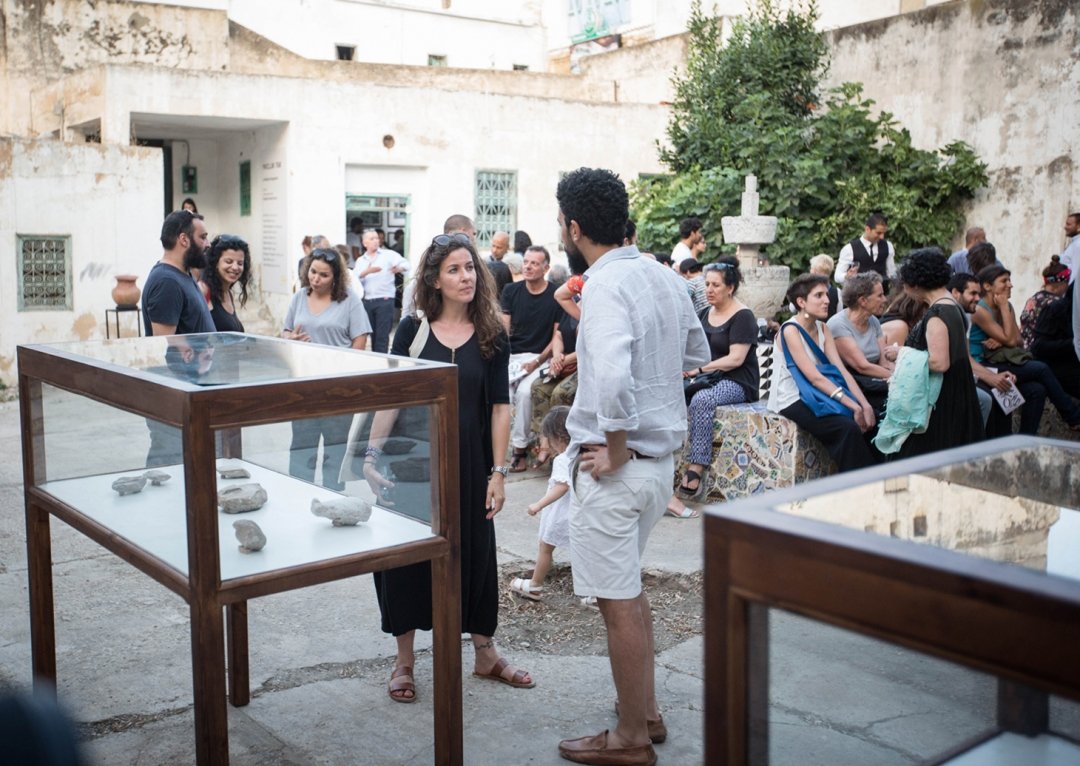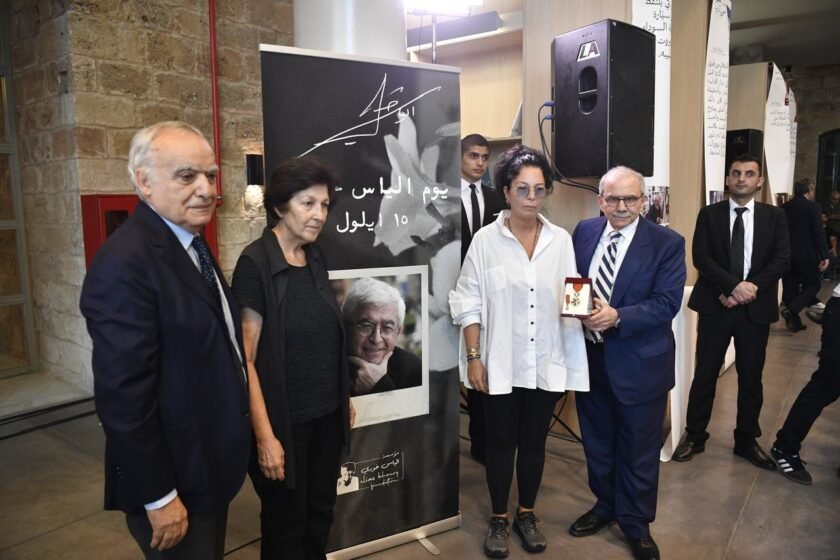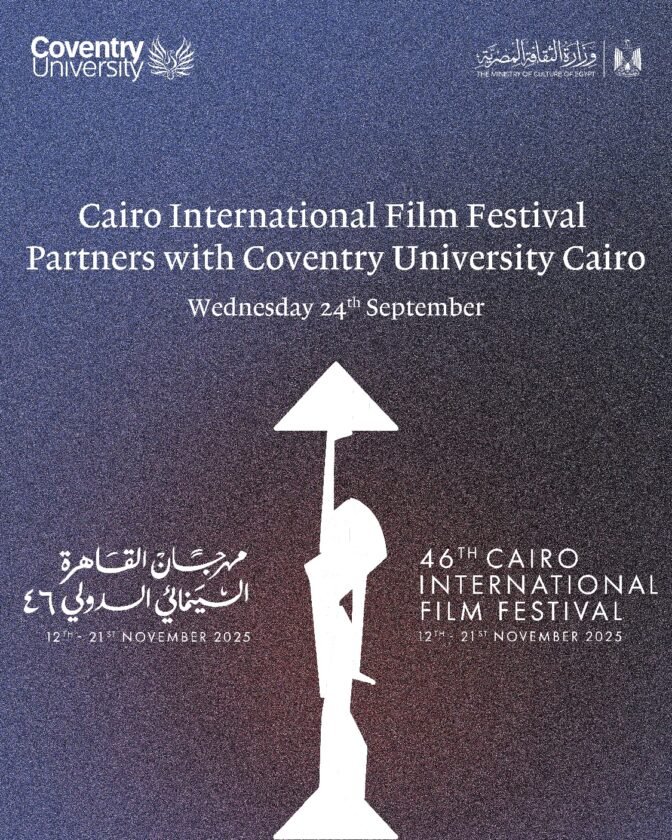The 5th edition of Jaou Tunis at the Kamel Lazaar Foundation brings together the works of various North African artists in a beautiful and oftentimes political display.
Exhausted by sad political literalism, I passed into Tunisia for the 5th edition of Lina Lazaar’s Jaou Tunis contemporary art festival feeling jinxed, as jingoist Donald Trump’s Muslim travel ban had been approved by the stolen Supreme Court that very day. I was a dispirited, appalled American entering North Africa, where I should have received an evil eye. Much of the art I encountered here thrives on this subtle irony. Instead of being rejected, I was kindly received for the five-day contemporary art festival, which brought together art lovers, journalists, gallerists, academics, and collectors from Tunisia and beyond.

Featuring 40 artists, many of them North African, Jaou Tunis 2018 seeks to explore the definition of “heritage” in post-revolution Tunisia. (The Jaou organization was founded in 2013 by Ms. Lazaar, who is the vice president of the non-profit Kamel Lazaar Foundation.) From today’s perspective, the Arab Spring that initially sprung from the Tunisian Revolution — sparked by the self-immolation of Mohamed Bouazizi on December 17, 2010 — seems rather distant, and the art world dialogues of the time seem characterized by exaggerated hopes for cultural progress. This year’s Jaou Tunis touches on the parallel arches of aggrandized-to-dashed aspirations that mark the history of European modernism and American pop art, as those western art movements ran out their course.

The festival has a regional focus on sunny jaou (fun), with “Silence” and the four elements of cosmological magic — Air, Fire, Water, and Earth — as its stated themes. This five-cornered gesture is a post-revolution symbolic return to un-trampled, transcendent Mother Nature. But Jaou Tunis 2018 doesn’t claim art is innocent — only that, when kept as an inner shrine to enchantment and intimacy, it is worth protecting and sharing.
The merits of silence were first touchingly addressed by “l’Orchestre Symbolique” (Symbolic Orchestra) with a theatrical performance called “Symphonie des silences” (Silent Symphony). Directed by Tunisian actor Bahram Aloui, “Symphonie des silences” featured the mime-like silent movements of deaf actors, including Omnia Ben Slimen, Ziyede Cherni, Siwar El Bahrouni, Emna Ghariani, Takwa Mechergui, Raouf Messai, and Mohamed Ouni. The historic venue — the Ancienne Bourse du Travail building, an old labor exchange and site of political organizing — contains two murals by the Tunisian modernist painter Hatem El Mekki. Particularly moving at the start, the performance ran overly long, dulling its impact.

Just outside, I dug the Stambeli sounds of musician Mohamed Khachnaoui’s group, Dendri Stambeli Movement. A genre of healing trance music created by the descendants of sub-Saharan slaves brought to Tunisia during the eighteenth and nineteenth centuries, Stambeli features the traditional North African instruments dabdabou, gombri, gambra, and chkacha. Khachnaoui’s version mixed in western piano, drums, bass, and electric guitar.

The silence thus broken, four Tunisian women co-curators — Myriam Ben Saleh, Amel Ben Attia, Khadija Hamdi-Soussi, and Aziza Harmel — deftly handled the visual art, presented in four pavilions named for the four elements. These exhibitions were all situated in aged, raw spacesof Tunisian heritage. The presentation reminded me of the golden age of post-punk art in the New York City downtown scene of the 1970s and early ’80s, where scuzzy art shows made themselves comfortable within architectural decay: for example, Collaborative Projects’ seminal The Times Square Show, at an abandoned massage sex parlor in Times Square; The Real Estate Show, on the Lower East Side, which led to ABC No Rio; and, of course, Alanna Heiss’s MoMA PS1.

Adventurous Tunisians come to contemporary art not only to have fun, but also to flirt with non-theist ideas and become, in spirit, ever more emancipated. And there is much emancipatory cultural work to be done in Tunisia, as consensual same-sex activity is still a crime there. Appalling! But beyond this particular form of backwardness, other social work is being done in the cultural domain, and the Kamel Lazaar Foundation’s Jaou project is playing a large part.
In 2015, in an effort to reflect on the possibilities of secular Islam in Tunisia, Jaou staged an ambitious exhibition, called All the World’s a Mosque, in Carthage, near the El Abidin Mosque. The Foundation created a mosque/museum out of 22 shipping containers, in which they presented the work of 22 artists from across the Arab-Muslim world.
For the opening, which included a female-led call to prayer, a large group of Islamic fundamentalists had initially prepared to attack the site with clubs, but were assuaged when a local grand Imam blessed the site at the last minute.
Last year’s 4th edition of Jaou Tunis, also focused on a hot, knotty topic: A Nation of Migration. But this year’s back-to-basics theme looks to the past — all the way to Greek philosopher Empedocles and his cosmogenic theory of the four elements as the root of all matter.
Indeed, Jaou Tunis 2018 seems eager to ferret out the enormity of current ill situations by going elemental. It reminds us that the magic of art remains fully alive only when we set ourselves immeasurable goals for it. We artists are magnificent at making humongous futile gestures. No problem.

In various branches of ritual Elemental Magic, the four elements are thought to be of social-political value when used in casting a sacred circle of resistance and protection. One basic tenet of many magical practices is that everything is made up of some combination of the four elements, and if one understands and tweaks these combinations, one can transfigure reality.
Here, this tweaking is done in connection with the mystical qualities of North African art. Much of the work on view mixed appealing regional symbols — many of which originated in pre-Islamic Berber motifs — with a whole bouillabaisse of other ethnic identities, both ancient and modern. (Clearly, the repetitive geometric patterns typical of North African aesthetics appealed to modern artist Paul Klee during his career-changing stay in Tunisia.)
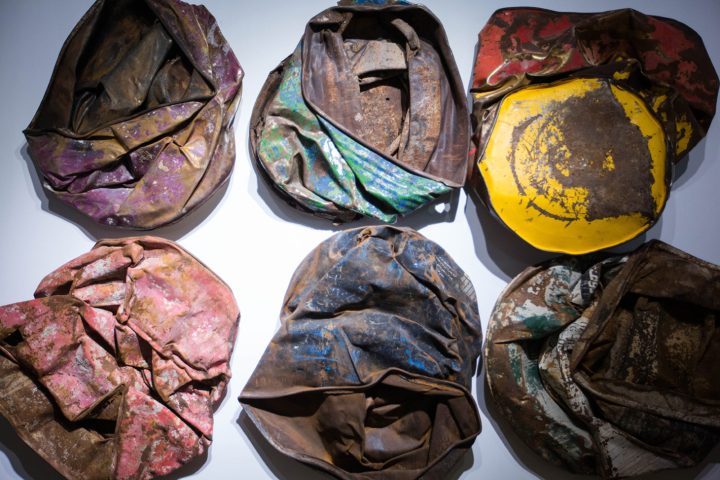
In Jaou Tunis 2018, many North African and Muslim artists explore the formal dimensions of ancient magical symbols, synthesizing new symbols of hope and free expression from hoary pagan forms. Judging by what I saw here, these artists, many of whom live and work out of multiple cities, have a large reservoir of cultural references that nourish their postmodern work, connecting cultural identity to the nerve of their emotional lives. Yet they also seem to sense that the act of remembering is rooted in ever-changing time; that our understanding of the past is contingent on the present and vice versa.

My preferred pavilion is Earth/Trab – Le Musée Imaginaire, in the medina at La Zaouïa de Sidi Boukhrissane. Here, curator Khadija Hamdi-Soussi salutes art historian André Malraux’s idea of an imaginary “museum without walls“. First announced in 1947, Malraux’s concept was a prescient manifesto of our digital age’s virtualization and dislocation of the physical art object and the museum, via reproduction systems that privilege flux, assembling, grouping, and displaying art over making new, original art.
Hamdi-Soussi perfectly exemplifies this by including Ali Cherri’s dans la lune (crazy) dream video-loop “Somniculus” (2017). High-quality noise music — containing hints of riffs from The Ramones‘ 1978 punk anthem “I Wanna Be Sedated” — accompanies intense museum art imagery that Cherri photographed and assembled in a dazzling flux. Also in this ilk is the Palestinian artist Hazem Harb’s “Reformulated Archeology” (2018) collage-based graphic art project, which incorporates old maps and photographs of Palestine most effectively. Harb’s work’s insistence that visceral memory of the land of Palestine is stronger than domination and occupation provides insight into the occupation of Palestine without being terribly original visually. But his vision of time is far more radical than Proust’s.
Connected to the North direction in ritual Elemental Magic, Earth is considered the ultimate feminine goddess element: fertile, stable, strong, and nurturing. This point was made by the Algerian artist Yazid Oulab’s black wall relief “Coin I” (2018) — which suggests an abstracted sex of a woman — and the delicate graphic work of Farah Khelil and Haleh Redjaian’s light-touch installation “La Trace de Reverie” (2018).
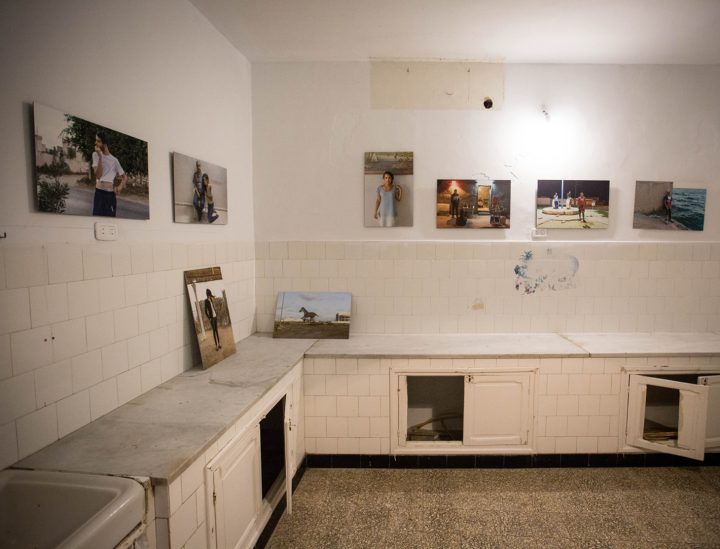
At Colomb L’Eglise de l’Aouina in curator Myriam Ben Saleh’s Water/Mé – Water Pressure pavilion (the only pavilion now closed due to usage constraints), the force of water flow is schematized. In magic, water is highly charged feminine energy, and Ligia Lewis’s solo dance performance “So Something Happened, Get Over It; No, Nothing Happened, Get With It” shaped the show by instinctively flowing into and resisting the liquidity of her consciousness, at times appearing ungovernable as a river, a force overwhelming her, but never drowning her. Beirut-based film director Jessy Moussallem’s “Untitled” (2018) video projection — starring the same veiled female figures the artist featured in her music video for Lebanese indie rock band Mashrou’ Leila — also emphasizes women’s strength. Moussallem’s controversial intention is to disturb the global narrative of secularized white feminism, which positions itself as being ideologically incompatible with fundamentalist Islam.
Standing in a flooded, ruined bathroom, Alex Ayed’s weirdly fleshy “Untitled” (2018) olive oil soap sculpture seemed from another planet, while Ayla Hibri’s photos of male and female boxing students, “Untitled” (2018), reminds the visitor that L’Eglise de l’Aouina, the show’s venue, currently houses a boxing school. Lydia Ourahmane’ssound installation “Second Soufflé” (Second Breath, 2018) doubles down on this: it was recorded in-situ at the boxing school by zooming in on the breath of the young boxers during their warm-up routine. The French phrase second soufflé indicates that after being knocked out, one can pick oneself up again and go for the win. Ourahmane thus offers a powerful poetic analogy for the psychic state of Tunisian youth.
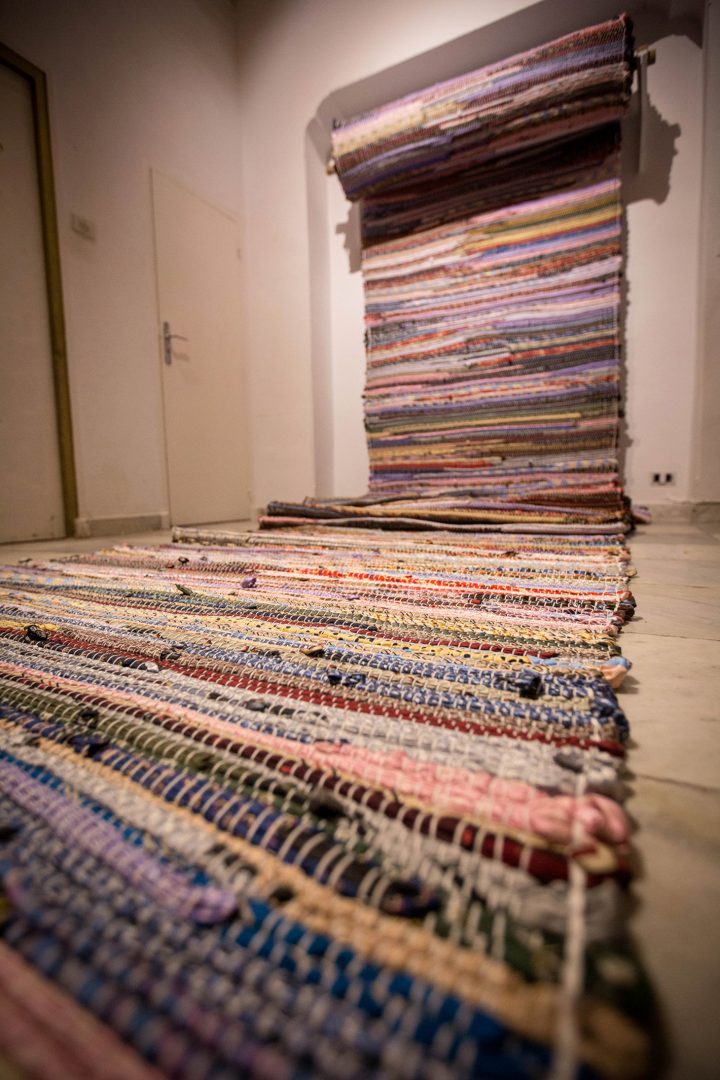
Used for cleansing and purification, Water is connected in various magical traditions to the West, and associated with passion and emotion, but Western European celebu-artist Philippe Parreno’scontribution “My Room Is Another Fishbowl” (2016) had neither. While I am generally fond of preposterous people, Parreno’s fatuous floating fish-shaped balloons seemed literally FedExed in, empty of any genuine substance.

At Dar Baccouche, curator Aziza Harmel’s pavilion, titled“Air/Hwé – Ruins are what mortals do as they live”, explores the magical element associated with the East and the breath. It features Naeem Mohaiemen’smagnificent three-channel digital video installation “Two Meetings and a Funeral” (2017), which was originally commissioned by documenta 14and co-commissioned by Sharjah Art Foundation and Ford Foundation Just Films. Though too long for a gallery setting (85 minutes) it is a tour de force of dashed revolutionary dreams concerning the Non-Aligned Movement in the 1970s. Projected on three large screens, the piece has a flowing, gliding pace that feels pliable yet historically detailed. The reallocating documentary imagery feels wedded to the shifting style, illuminating the piece’s innermost theme of merciless transience in the world of leftist (anti-Soviet and anti-American) ideological politics. With a seemingly endless cascade of hypnotic, charismatic imagery, Mohaiemen appears in total control of the material, and drew me into something worthwhile and exhilarating.
Mohamed Ben Slama, one of the few painters in the show, presents a playful diptych, titled “Green Fields are Calling” and “It’s Falling in a Golden Door” (both 2018), which send out smoke signals from swimming pools of oil. The diptych’s dialogue is enhanced by a backdrop of a blue-and-white-patterned ceramic frieze, a permanent fixture of the house in which the show is mounted. The house’s grungy kitchen also nicely frames Kamel Moussa’s series, “Equilibre Instable” (2012), photos of somewhat dazed and confused post-revolution Tunisian youth in a country torn between secular progressives and religious conservatives. Patricia Esquivias’s mixed media graphic work, “111-119, Generalismo castella” (2012), stresses the constant need for different visual languages when each flickering moment demands a different self, while Fotini Gouseti’s waggish shaggy carpet, “Kalavryta” (2012), woven from 2,000 silk ties, pulls the proverbial rug out from under men who need to wear ties to feel sufficiently potent.
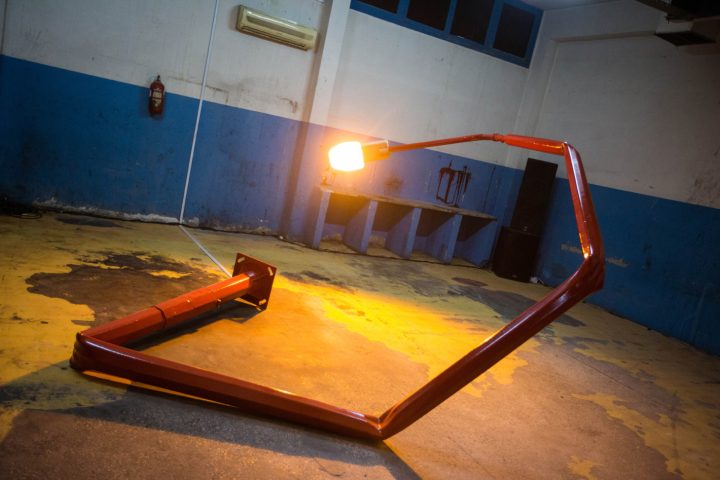
Curator Amel Ben Attia’s Fire/Naar : J’emporterai le feu (I Will Take the Fire) pavilion, in “El Matbaa, l’Imprimerie Cérès”, is full of first-rate pieces. Maha Malluh’s wall piece “Oil Candies” (2012), made of compressed oil barrels, recalls the Nouveau réalisme artist César Baldaccini’s “Compressions”. Ymane Fakhir’s impactful video and graphic arts presentation, “The Lion’s Share” (2017), tells the story of a bereaved Muslim family and their negotiation of shares in an inheritance, illuminating the institutional sexism in Muslim inheritance laws. Also intriguing is Mohssin Harraki’s twisted mixed-media sculpture “Reverbere” (2015), and Mehdi-Georges Lahlou’s smoking sculpture “Equilibre à l’Encensoir” (2018), which perfectly fits the fire theme with its burning aroma.
Younes Ben Slimane’s burnt block sculpture “Les Combustibles” (2018) and Sonia Kallel’s haunting ceramic dress “Robe Idole de Sejnane” (2011) are powerful presences that evoke the Greek myth of the phoenix rising from the ashes of its predecessor. Emotionally moving in another direction was Zineb Sedira’s video triptych “Mother Tongue” (2002), which depicts discursive exchanges between three generations of women falling into non-discursive frustration. On one screen, the artist talks with her elderly mother in Arabic; on the center screen, the artist talks to her young daughter in French and English; and on the third screen, grandmother and granddaughter are unable to communicate in any language. “Mother Tongue” convincingly accesses emotive fragments of generational female experience within a framework of formalist rigor.

Performance-wise, it was easy to flow into the thrill of “Curtains,” Asmahan Tlig’s live belly dance, which reached ecstatic heights with the help of Haythem Achour’s excellent electronic relaxed-harsh noise piece, “Ogre.”

Though elementary, dear Watson, much in Jaou Tunis 2018 is a kind of political hot-soft power that cools down the cultural religious values of ideological people who have historically subordinated women. Its art-as-magic transfigures, suggesting that North Africa is brimming with imagination, strength, and beauty, and that the region need not stall or go in reverse now, as America has done with Trump, to put it lightly. I concede that little here is Byronic or redolent with mocking double meanings, but when people are wise and tenacious, they love fun and nature more than dogma or ideology. I feel in my bones here a promising respect for the old magical gods who have little to do with philosophical systems or political orders.

So the 5th edition of Jaou Tunis reminds us that when managing badly in the social-political world, we can always look out the window at the gods of nature to see balance, beauty, and growth that shames the hollow dummies who stifle elemental human rights.
The author’s travel and hotel costs were provided by the communications department of the nonprofit Kamel Lazaar Foundation.
The 5th edition of Jaou Tunis is on display at the Kamel Lazaar Foundation until July 27.
TunisianMonitorOnline (Hyperallergic)

